View in other NatureServe Network Field Guides
NatureServe
Montana
Utah
Wyoming
Idaho
Wisconsin
British Columbia
South Carolina
Yukon
California
New York
Pallid Sturgeon - Scaphirhynchus albus
State Rank Reason (see State Rank above)
Wild origin fish continue to decline and species faces significant threats
General Description
The Pallid Sturgeon is the larger of the two species of sturgeon found east of the Continental Divide. Both sturgeon species, Pallid and Shovelnose, co-occur in the Missouri and Yellowstone Rivers. Pallid sturgeons have a unique dinosaur-like appearance and have been swimming around since the dinosuars. They have a flattened snout, long slender tail and are armored with lengthwise rows of bony plates instead of scales. Their mouth is toothless and positioned under the snout for sucking small fishes and invertebrates from the river bottom. Pallid sturgeon can weigh up to 80 pounds and grow to about 6 feet long.
For a comprehensive review of the ecology, conservation status, threats, and management of this and other Montana fish species of concern, please see
Montana Chapter of the American Fisheries Society Species of Concern Status Reviews.Diagnostic Characteristics
The Pallid Sturgeon is a large fish (to 186 centimeters) with a heterocercal tail, a long slender caudal peduncle, a flat shovel-shaped snout, four fringed barbels on the snout, a ventral mouth, and large bony scutes on the head, back, and sides; 37 to 43 dorsal rays; 24 to 28 anal rays (Page and Burr 1991). The Pallid Sturgeon is similar to the Shovelnose Sturgeon but has no scale-like scutes on the belly, the bases of the outer barbels usually are posterior to the bases of the inner barbels, the inner barbels are shorter, the head is larger, the mouth is wider, the eye is smaller, and the color is usually paler (gray-white above and on sides) (Page and Burr 1991).
Species Range
Montana Range
Range Descriptions
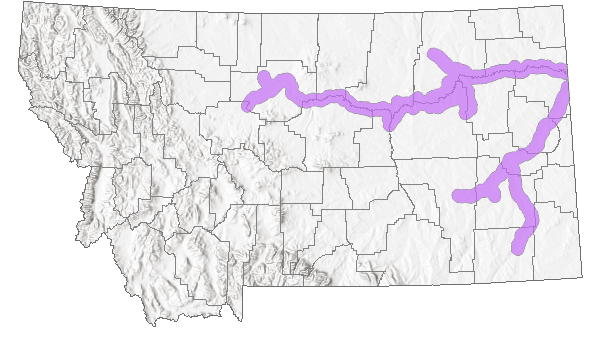
 Native
Native
Western Hemisphere Range
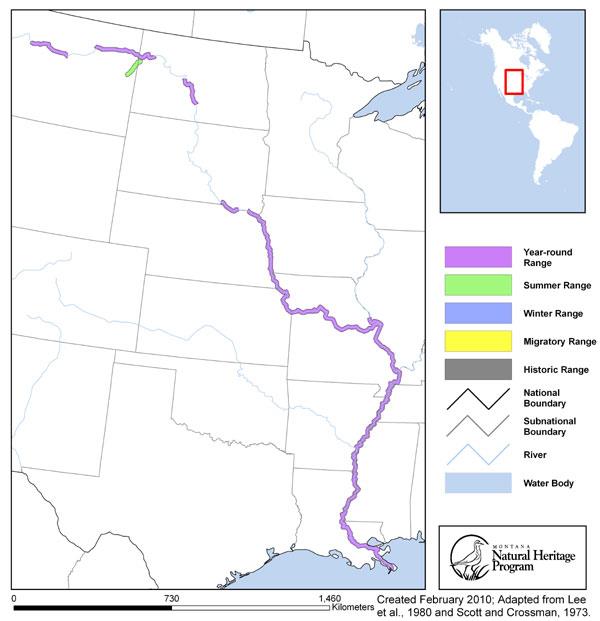
Range Comments
Pallid sturgeon are scarce in the upper Missouri River above Ft. Peck Reservoir; scarce in the Missouri and lower Yellowstone Rivers between Ft. Peck Dam and Lake Sakakawea; very scarce in the other Missouri River reservoir reaches; scarce in the Missouri River downstream of Gavins Point Dam. They are slightly more common in the Mississippi and Atchafalaya Rivers;
Observations in Montana Natural Heritage Program Database
Number of Observations: 144
(Click on the following maps and charts to see full sized version)
Map Help and Descriptions
Relative Density
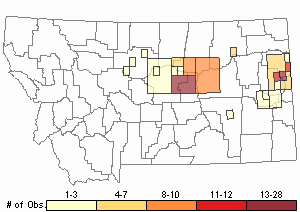
Recency
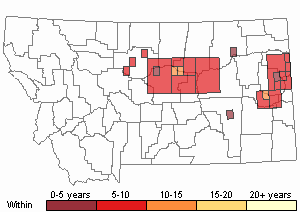

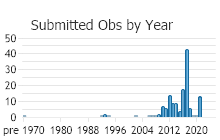
 (Observations spanning multiple months or years are excluded from time charts)
(Observations spanning multiple months or years are excluded from time charts)
Migration
Pallid Sturgeon use the lower Yellowstone River primarily during spring and summer, but during fall and winter use the Missouri River below the confluence with the Yellowstone (Tews 1994, Bramblett 1996). Some Pallid Sturgeon use the Fort Peck tailrace yearlong, but others move downstream in spring (in one case more than 300 kilometers) (Tews 1994).
Habitat
Pallid Sturgeon use large, turbid rivers over sand and gravel bottoms, usually in strong current; also impoundments of these rivers (FWP). In Montana, Pallid Sturgeon use large turbid streams including the Missouri and Yellowstone rivers (Brown 1971, Flath 1981). They use all channel types, primarily straight reaches with islands (Bramblett 1996). They primarily use areas with substrates containing sand (especially bottom sand dune formations) and fines (93% of observations) (Bramblett 1996). Stream bottom velocities ranged between 0.0 and 1.37 meters per second, with an average of 0.65 meter per second (Bramblett 1996). Depths used were 0.6 to 14.5 meters and averaged 3.30 meters, and they appeared to move deeper during the day (Bramblett 1996). Channel widths from 110 to 1100 meters are used and average 324 meters (Bramblett 1996). Water temperatures used ranged from 2.8 to 20 degrees C. (Tews 1994, Bramblett 1996). Water turbidity ranged from 12 to 6400 NTU (Turbidity Units) (Tews 1994).
Food Habits
Aquatic insects and minnows have been found in the stomachs of Pallid Sturgeon (Brown 1971).
Ecology
Annual home ranges for Pallid Sturgeon in Montana ranged from 12.4 to 331.2 kilometers with a median of 52 kilometers; seasonal home ranges were smaller in fall and winter than in spring and summer (Bramblett 1996). Sturgeon were found to have moved 54% of the time between relocations; they moved up to 21.4 kilometers per day and 9.5 kilometers per hour (Bramblett 1996). Adult females are generally larger than males.
Adult Pallid Sturgeon populations in Montana display a skewed size structure comprised of only large (old-age) fish (
Montana AFS Species Status Account).
Reproductive Characteristics
Once Pallid Sturgeon spawn the resulting larvae have a strong tendency to drift great distances downstream over a long period of time (Kynard 1998). This behavior is thought to be one of the limiting factors affecting larval survival. It has been suggested that larval Pallid Sturgeon may end up being deposited in downstream reservoirs and consequently never reach suitable rearing habitat. Pallid Sturgeon are long-lived and are thought to spawn at several year intervals. Females may not reach sexual maturity until they are 15 to 20 years old (Dryer and Sandvol 1993). Because of unique biological characteristics, including obligatory lengthy migrations and larval drift distances, high habitat specificity and late sexual maturity, Pallid Sturgeon is a species vulnerable to extirpation (
Montana AFS Species Status Account).
Management
Beginning in 1996, research efforts focused on Pallid Sturgeon recovery and preserving the Pallid Sturgeon genetic pool through stocking. The main purpose of the stocking program is to preserve the genetic pool and reconstruct an optimal population size within the habitat's carrying capacity (Krentz 1997,
Montana AFS Species Status Account).
One of the most obvious detrimental changes in the Pallid Sturgeon environment was the damming of the Missouri River and several other important tributaries. Efforts are now being directed at restoring the river to a more normal condition. In 2000, the U.S. Fish and Wildlife Service (USFWS) completed an Endangered Species Act consultation with the U.S. Army Corps of Engineers regarding operation of Missouri River dams. Through an informal agreement the U.S. Bureau of Reclamation (BOR) has agreed to provide a dominant discharge spring pulse out of Tiber Reservoir every 4 to 5 years for Missouri River fish migrations which could help the Upper Missouri River Pallid Sturgeon population. To address Pallid Sturgeon passage and entrainment on the Yellowstone River, the USFWS has begun consultation with BOR regarding problems at Intake Diversion Dam. The future for Pallid Sturgeon recovery may continue to be uncertain even after positive changes have been implemented because Pallid Sturgeon populations are so depleted and the newly stocked fish will take at least 15 years before the females first reach sexual maturity and begin to spawn. Therefore, it is important to realize that immediate evaluations are impractical and recovery will take a dedicated, long-term commitment (
Montana AFS Species Status Account).
Implementing the Pallid Sturgeon recovery program in this area is a multi-state and agency task. To facilitate this, the Montana/Dakota Pallid Sturgeon workgroup was organized in 1993. The group is comprised of representatives from MTFWP, NDGF, USFWS, USBOR, WAPA and PPL-MT, and acts in an advisory role identifying research needs and funding sources, developing workplans and providing an opportunity for communication between biologists and agency personnel (
Montana AFS Species Status Account).
Additional information on the biology and management of Pallid Sturgeon populations can be found on the U.S. Fish and Wildlife Service's
Environmental Conservation Online System Species ProfileStewardship Responsibility
References
- Literature Cited AboveLegend:
 View Online Publication
View Online Publication Bramblett, R.G. 1996. Habitats and movements of pallid and shovelnose sturgeon in the Yellowstone and Missouri Rivers, Montana and North Dakota. Ph.D. Dissertation. Bozeman, MT: Montana State University. 210 p.
Bramblett, R.G. 1996. Habitats and movements of pallid and shovelnose sturgeon in the Yellowstone and Missouri Rivers, Montana and North Dakota. Ph.D. Dissertation. Bozeman, MT: Montana State University. 210 p. Brown, C.J.D. 1971. Fishes of Montana. Bozeman, MT: Big Sky Books/Montana State University. 207 p.
Brown, C.J.D. 1971. Fishes of Montana. Bozeman, MT: Big Sky Books/Montana State University. 207 p. Flath, D. L. 1981. Vertebrate species of special interest or concern. Wildlife Division of Montana Department of Fish, Wildlife, and Parks.
Flath, D. L. 1981. Vertebrate species of special interest or concern. Wildlife Division of Montana Department of Fish, Wildlife, and Parks. Krentz, S. 1997. Summary report of work conducted by the Missouri River FWMAO on Missouri and Yellowstone Rivers - pallid sturgeon. Report # MRFAO97-03. US Fish and Wildlife Service. Bismarck, ND. 6 pp.
Krentz, S. 1997. Summary report of work conducted by the Missouri River FWMAO on Missouri and Yellowstone Rivers - pallid sturgeon. Report # MRFAO97-03. US Fish and Wildlife Service. Bismarck, ND. 6 pp. Kynard, B. 1998. Twenty-two years of passing shortnose sturgeon in fish lifts on the Connecticut River: what has been learned? Pp. 255-264 In: Fish migration and fish bypasses. M. Jungwirth, S. Schmutz, and S. Weiss (eds.). Fishing News Books, London.
Kynard, B. 1998. Twenty-two years of passing shortnose sturgeon in fish lifts on the Connecticut River: what has been learned? Pp. 255-264 In: Fish migration and fish bypasses. M. Jungwirth, S. Schmutz, and S. Weiss (eds.). Fishing News Books, London. Lee, D.S., C.R. Gilbert, C.H. Hocutt, R.E. Jenkins, D. E. McAllister, J. R. Stauffer, Jr. 1980. Atlas of North American freshwater fishes. North Carolina State Musuem of Natural History. 867 p.
Lee, D.S., C.R. Gilbert, C.H. Hocutt, R.E. Jenkins, D. E. McAllister, J. R. Stauffer, Jr. 1980. Atlas of North American freshwater fishes. North Carolina State Musuem of Natural History. 867 p. Montana Chapter of the American Fisheries Society species status accounts.
Montana Chapter of the American Fisheries Society species status accounts. Page, L.M. and B.M. Burr. 1991. A field guide to freshwater fishes. The Peterson Field Guide Series, Houghton Mifflin Co., Boston. 432 pp.
Page, L.M. and B.M. Burr. 1991. A field guide to freshwater fishes. The Peterson Field Guide Series, Houghton Mifflin Co., Boston. 432 pp. Scott, W.B. and E.J. Crossman. 1973. Rainbow trout, Kamloops trout, Steelhead trout Salmo gairdneri Richardson. pp. 184-191. In: Freshwater fishes of Canada. Ottawa, Canada: Fisheries Research Board of Canada, Bulletin 184. 966 p.
Scott, W.B. and E.J. Crossman. 1973. Rainbow trout, Kamloops trout, Steelhead trout Salmo gairdneri Richardson. pp. 184-191. In: Freshwater fishes of Canada. Ottawa, Canada: Fisheries Research Board of Canada, Bulletin 184. 966 p. Tews, A.E. 1994. Pallid sturgeon and shovelnose sturgeon in the Missouri River from Fort Peck Dam to Lake Sakakawea and in the Yellowstone from Intake to its mouth. Fort Peck pallid sturgeon study. MTFWP Final Report to U.S. Army Corps Engineers. 87 p.
Tews, A.E. 1994. Pallid sturgeon and shovelnose sturgeon in the Missouri River from Fort Peck Dam to Lake Sakakawea and in the Yellowstone from Intake to its mouth. Fort Peck pallid sturgeon study. MTFWP Final Report to U.S. Army Corps Engineers. 87 p.
- Additional ReferencesLegend:
 View Online Publication
View Online Publication
Do you know of a citation we're missing? Albers, Mark., 1995, Draft Biological Assessment: Tongue River Basin Project. May 1995. In Tongue River Basin Project Draft Environmental Impact Statement. Appendix B. June 1995.
Albers, Mark., 1995, Draft Biological Assessment: Tongue River Basin Project. May 1995. In Tongue River Basin Project Draft Environmental Impact Statement. Appendix B. June 1995. Clancey, P. 1989. Fort Peck pallid sturgeon study. Unpublished report to the U.S. Army Corps of Engineers. Montana Department of Fish, Wildlife, and Parks. 25 p.
Clancey, P. 1989. Fort Peck pallid sturgeon study. Unpublished report to the U.S. Army Corps of Engineers. Montana Department of Fish, Wildlife, and Parks. 25 p. Clancy, P. 1992. Fort Peck pallid sturgeon study. MTFWP, submitted to U.S. Army Corps of Engineers, Planning Branch, Omaha, NB. 35 p.
Clancy, P. 1992. Fort Peck pallid sturgeon study. MTFWP, submitted to U.S. Army Corps of Engineers, Planning Branch, Omaha, NB. 35 p. Cox, Tanner Lewis. 2020. Reproductive ecology of hatchery-origin Pallid Sturgeon upstream of Fort Peck Reservoir, Montana. M.S. Thesis. Montana State University, Bozeman, MT. 88 pp.
Cox, Tanner Lewis. 2020. Reproductive ecology of hatchery-origin Pallid Sturgeon upstream of Fort Peck Reservoir, Montana. M.S. Thesis. Montana State University, Bozeman, MT. 88 pp. Djokic, M.A. 2020. An expansion of nonlethal tools for use on juvenile Pallid Sturgeons in the upper basin of the Missouri River. M.Sc. Theis. Bozeman, MT: Montana State University. 127 p.
Djokic, M.A. 2020. An expansion of nonlethal tools for use on juvenile Pallid Sturgeons in the upper basin of the Missouri River. M.Sc. Theis. Bozeman, MT: Montana State University. 127 p. Dryer, M.P. and A.J. Sandvol. 1993. Pallid sturgeon (Scaphirhynchus albus) recovery plan. Bismarck, ND: U.S. Fish and Wildlife Service. 55 p.
Dryer, M.P. and A.J. Sandvol. 1993. Pallid sturgeon (Scaphirhynchus albus) recovery plan. Bismarck, ND: U.S. Fish and Wildlife Service. 55 p. Duncan, M.B. 2019. Distributions, abundances, and movements of small, nongame fishes in a large Great Plains river network. Ph.D. Dissertation. Bozeman, MT: Montana State University. 255 p.
Duncan, M.B. 2019. Distributions, abundances, and movements of small, nongame fishes in a large Great Plains river network. Ph.D. Dissertation. Bozeman, MT: Montana State University. 255 p. Gerrity, P.C. 2005. Habitat use, diet, and growth of hatchery-reared juvenile pallid sturgeon and indigenous shovelnose sturgeon in the Missouri River above Fort Peck Reservoir. M.Sc. Thesis. Bozeman, MT: Montana State University. 62 p.
Gerrity, P.C. 2005. Habitat use, diet, and growth of hatchery-reared juvenile pallid sturgeon and indigenous shovelnose sturgeon in the Missouri River above Fort Peck Reservoir. M.Sc. Thesis. Bozeman, MT: Montana State University. 62 p. Holmquist, L.M. 2017. Reproductive ecology of hatchery-origin and wild Palllid Sturgeon in the Missouri River above Fort Peck Reservoir, Montana. M.Sc. Thesis. Bozeman, MT: Montana State University. 137 p.
Holmquist, L.M. 2017. Reproductive ecology of hatchery-origin and wild Palllid Sturgeon in the Missouri River above Fort Peck Reservoir, Montana. M.Sc. Thesis. Bozeman, MT: Montana State University. 137 p. Joslin, Gayle, and Heidi B. Youmans. 1999. Effects of recreation on Rocky Mountain wildlife: a review for Montana. [Montana]: Montana Chapter of the Wildlife Society.
Joslin, Gayle, and Heidi B. Youmans. 1999. Effects of recreation on Rocky Mountain wildlife: a review for Montana. [Montana]: Montana Chapter of the Wildlife Society. Kallemeyn, L. 1983. Status of the pallid sturgeon. Fisheries 8(1):3-9.
Kallemeyn, L. 1983. Status of the pallid sturgeon. Fisheries 8(1):3-9. Lance, M.J. 2019. Spatial and temporal variability in movements and vital rates of sympatric salmonids in an unfragmented, inland watershed. M.Sc. Thesis. Bozeman, MT: Montana State University. 116 p.
Lance, M.J. 2019. Spatial and temporal variability in movements and vital rates of sympatric salmonids in an unfragmented, inland watershed. M.Sc. Thesis. Bozeman, MT: Montana State University. 116 p. Mullins, M.S. 1991. Biology and predator use of cisco (Coregonus artedi) in Fort Peck Reservoir, Montana. M.Sc. Thesis. Bozeman, MT: Montana State University. 68 p.
Mullins, M.S. 1991. Biology and predator use of cisco (Coregonus artedi) in Fort Peck Reservoir, Montana. M.Sc. Thesis. Bozeman, MT: Montana State University. 68 p. Oldenburg, E.W. 2008. Effects of acclimation on poststocking dispersal of age-1 pallid sturgeon. M.Sc. Thesis. Bozeman, MT: Montana State University. 45 p.
Oldenburg, E.W. 2008. Effects of acclimation on poststocking dispersal of age-1 pallid sturgeon. M.Sc. Thesis. Bozeman, MT: Montana State University. 45 p. Phelps, S.R., and F.W. Allendorf. 1983. Genetic identity of pallid and shovelnose sturgeon (Scaphirhynchus albus and S. Platorynchus). Copeia (3):696-700.
Phelps, S.R., and F.W. Allendorf. 1983. Genetic identity of pallid and shovelnose sturgeon (Scaphirhynchus albus and S. Platorynchus). Copeia (3):696-700. Tews, A.E. and P. Clancey. 1993. Fort Peck pallid sturgeon study. MTFWP Final RepORT to U.S. Army Corps Engineers. 70 p.
Tews, A.E. and P. Clancey. 1993. Fort Peck pallid sturgeon study. MTFWP Final RepORT to U.S. Army Corps Engineers. 70 p. U.S. Fish and Wildlife Service. 1990. Endangered and threatened wildlife and plants; determination of endangered status for the pallid sturgeon. [50 CFR 17]. Federal Register 55(173):36641-36647.
U.S. Fish and Wildlife Service. 1990. Endangered and threatened wildlife and plants; determination of endangered status for the pallid sturgeon. [50 CFR 17]. Federal Register 55(173):36641-36647. USDI Bureau of Land Management. No date. Fishes of the Miles city, Montana BLM District. Miles City, MT: Miles City BLM District pamphlet. 12 p.
USDI Bureau of Land Management. No date. Fishes of the Miles city, Montana BLM District. Miles City, MT: Miles City BLM District pamphlet. 12 p. Williams, J.E., J.E. Johnson, D.A. Hendrickson, S. Contreras-Balderas, J.D. Williams, M. Navarro-Mendoza, D.E. McAllister, and J.E. Deacon. 1989. Fishes of North America endangered, threatened, or of special concern: 1989. Fisheries 14(6):2-20.
Williams, J.E., J.E. Johnson, D.A. Hendrickson, S. Contreras-Balderas, J.D. Williams, M. Navarro-Mendoza, D.E. McAllister, and J.E. Deacon. 1989. Fishes of North America endangered, threatened, or of special concern: 1989. Fisheries 14(6):2-20.
- Web Search Engines for Articles on "Pallid Sturgeon"
- Additional Sources of Information Related to "Fish"





